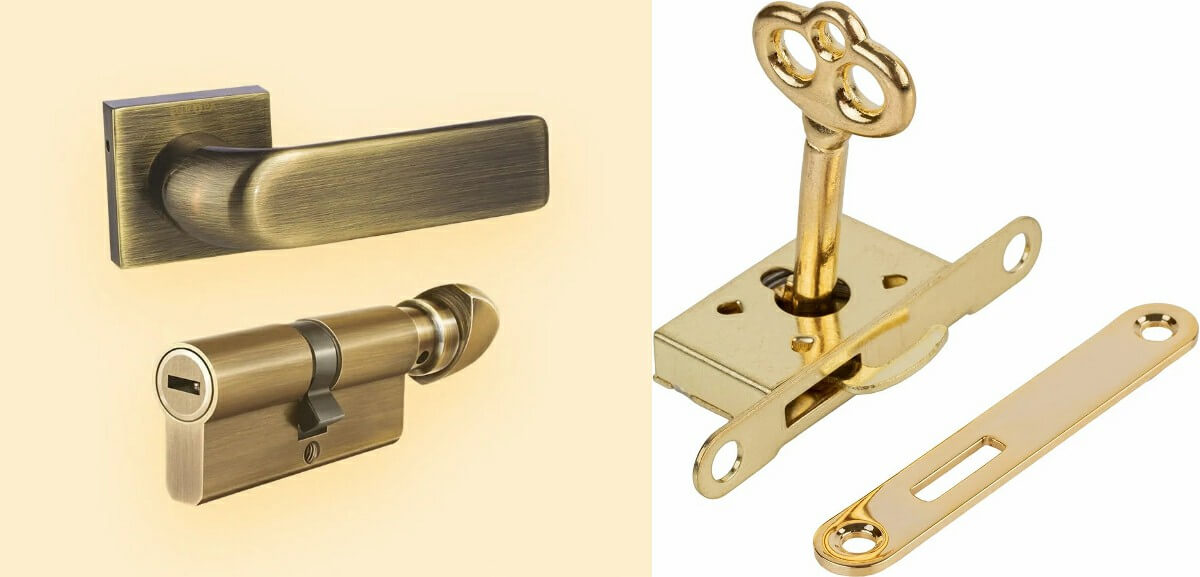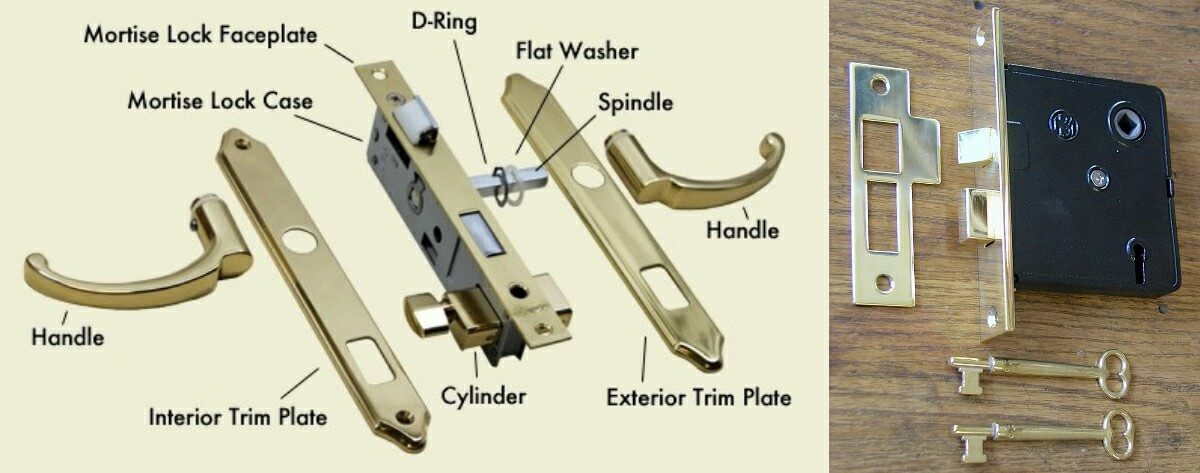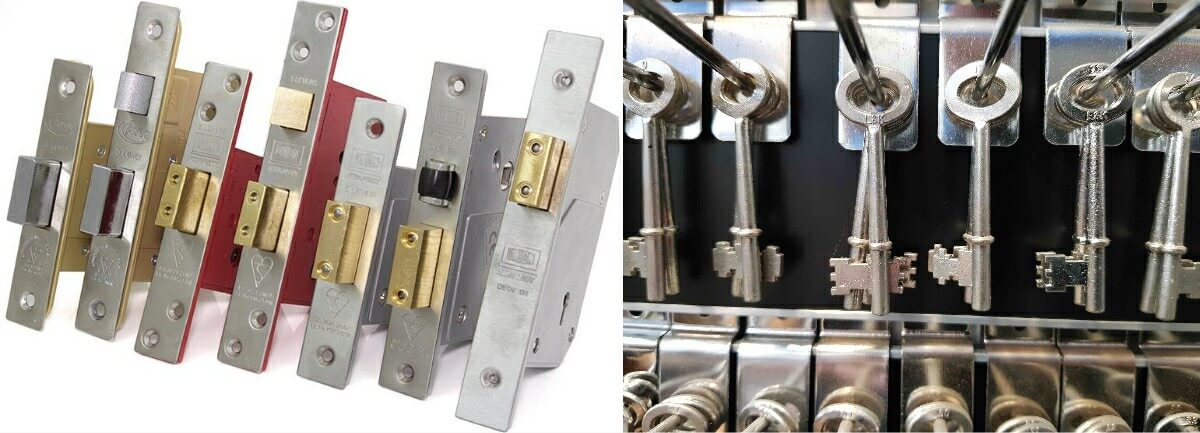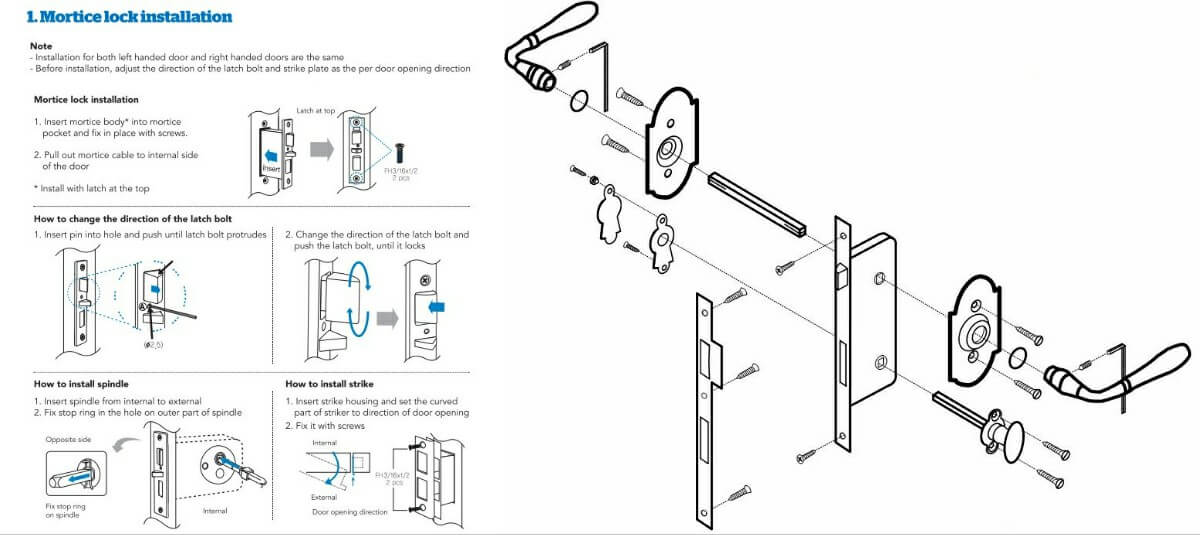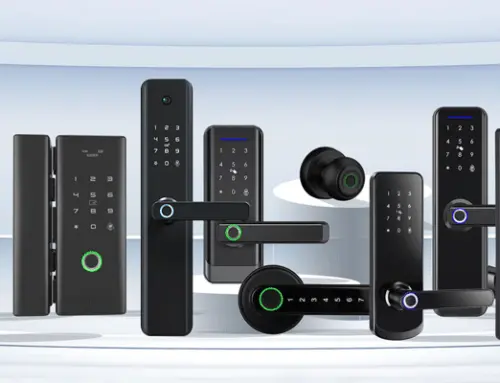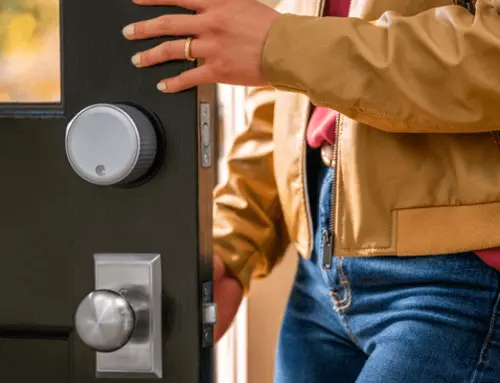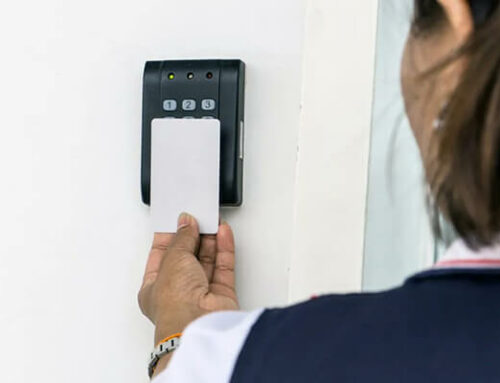Although there are many types of locks, each lock has its own unique advantages. But one of the most readily available and secure types of locks is the mortice lock. Today we are going to talk about mortise locks, in today’s guide all questions about mortise locks are answered. Whether you want to know the definition, how it works, or the pros and cons, you’ll find everything here. Read on to learn more.
1. What is a mortise lock and how it works
The reason a mortice lock is called a mortice lock is that the pocket (or mortise) into which the bolt goes is cut into the inside surface of the door frame. When the bolt is in the mortise, the door cannot move and is locked securely. Mortise locks consist of complex hardware that fits onto the door and is held in place by set screws, with a cam operating the locking mechanism. It requires a key to unlock the door, and when you insert the key into the lock, it unlocks the latch. The latch must be unlocked by turning the key in the opposite direction when you want to close the door again.
The working principle of the mortise door lock is mainly reflected in the movement process of the oblique tongue and the main tongue. The latch bolt relies on the compression and reset of the latch bolt spring to realize the opening and closing functions. It only plays the role of temporary locking. It mainly includes three kinds of movements, which are realized by rotating the handle, rotating the lock cylinder, and compressing the door frame.
The main tongue can only realize the function of opening and closing by turning the lock cylinder, which is equivalent to a latch and can play a real locking role. Concrete motion is under the situation that does not have a lock core dial effect, and the lock plate is pressed down the straight tongue plate tightly under the effect of spring, and the straight tongue is fixed, and is in a state that cannot move. When turning the dial of the lock cylinder, the lock plate is lifted, and the teeth of the straight tongue plate are moved to make the straight tongue protrude from the lock body to realize the opening. Reverse movement is used when closing.
2. History of mortice locks
- The first mortice locks were used by the Romans.
- Mortice locks have been used in the United States as part of a door hardware system since the eighteenth century.
- Mortice locks were found in the most formal rooms of the most expensive homes by the mid-nineteenth century.
- In 1805, Jefferson ordered 26 mortice locks for the main rooms.
- In 1819, mortice locks were used in the principal rooms of the Decatur Mansion in Washington, DC.
- In 1865, Linus Yale, Jr. innovated the mortice lock mechanism by placing the bolt, or the bolt itself, inside the door. This makes the key shorter.
- Mortise locks are still widely used to this day, and there are many different types.
3. Components of a mortice lock
A lock is composed of multiple parts, and the mutual cooperation between the parts can make the lock work best. Let’s take a look at the general components of a mortise lock.
- Lock shell: The lock shell is the shell that covers the outside of the door lock. It is made of galvanized steel SECC and is very hard. It contains the structure of the lock and plays a protective role.
- Lock body: The lock body is made of high-durability hard materials such as stainless steel and brass because it is the direct factor that determines the durability of the door lock.
- Lock Cylinder: The lock cylinder is a very important part of the door lock and is where unlocking and locking take place. It determines the durability and security of the lock.
- Door handle: The door handle is an indispensable part of the door lock. It not only has the function of decorating the door lock and making the door lock more beautiful, but it can also help us open the door lock faster. There are many types of door handles, you can choose your door handle according to your house decoration style.
- Strike Pad: The metal liner that sits inside the door frame hole. Its job is for the deadbolt to slide in, keeping the door closed.
- Key: Each door lock is equipped with a corresponding key, and the key materials are mainly made of hard metals such as copper, zinc, aluminum, iron, etc. This is to prevent the key from deforming. In addition, keys should be designed with many intricate details to avoid key duplication.
4. Advantages and disadvantages of using mortise locks
Like other door locks, mortise locks have advantages and disadvantages, let’s take a look at them together.
1) Advantages
- Security: The mortice lock is one of the most secure locks available today, it can be secured from both ends. This means you can lock the door from both sides (i.e. from the inside and the outside), which provides an extra layer of security for you. Also, another security advantage is that it must be opened with a key from the outside and a latch from the inside. This allows you to unlock it from the outside when you get home from work and lock it from the inside when you go to sleep at night.
- Variety of styles: Unlike old-fashioned mortise locks, modern mortise locks come in many different styles and colors, so you can easily find one that complements your home or office decor. This is one of the reasons why mortise locks are becoming more and more popular.
- EASY TO INSTALL: The mortice lock installation process is also so simple that you can do it yourself in less than an hour with basic tools.
- Good durability: The whole body of the mortise lock is made of hard materials such as steel and copper, which have good durability. Second, through abuse test research, the mortice lock can meet 1,000,000 cycles.
- Versatile: The mortise lock body has room for standard locking features, plus space for adding deadbolts, thumb turns, indicators, and other options. This makes the mortice lock have more locking functions.
2) Disadvantages
- Installation can be difficult: Above we said that mortice locks are easy to install, but that’s only when finding the right door. Because the mortice lock is installed in the hollow part of the door, this means that part of your door must be hollowed out to install it. And some doors are too thin to fit a mortice lock.
- Difficult to open when the key is stuck behind the door: Malfunctioning mortice locks can be difficult to open, especially if the key is stuck behind the door. At this time, you need to hire professional maintenance personnel to repair.
5. Types of mortise locks
Mortise locks can be divided into different types according to different classification standards.
1) In accordance with the occasion
Mortise locks can be divided into door locks and indoor locks according to the occasion of use.
- Door lock: Door lock is also called exterior door lock, safety lock, or anti-theft lock. It is generally used for the gate of the home, which is the watershed between the home and the outside, focusing on protection, sturdiness, and vandalism.
- Indoor lock: It plays the role of the door handle and slamming beads indoors. This kind of lock has no insurance function. It is suitable for door locks in kitchens, halls, living rooms, restaurants, and children’s rooms. It focuses on decoration.
2) According to the style
According to the style of the mortise lock, the mortise lock can be divided into old-fashioned domestic and European-style domestic.
- Old-fashioned domestic: Old-fashioned domestic refers to the traditional mortise lock style, which has two metal parts, the deadbolt, and the latch. An old house or building is usually where you will find this.
- European-style domestic production: Different from the old-style domestic production, European-style domestic production has only one component—the cylinder. The cylinder can operate both the deadbolt and the deadbolt, which means it is easier to install than the old homemade mortice locks. It can be said to be an evolutionary version of the old-fashioned domestic products. It is popular in many countries in Europe and has become more and more popular in North America in recent years.
3) According to the deadbolt
According to the type of bolt of the mortise lock, the mortise lock can be divided into single bolt mortise door lock, single bolt button mortise door lock, and double tongue mortise door lock.
- Single deadbolt mortise door: As the name suggests, a single deadbolt mortise door has only one deadbolt. According to the number of locks, it can be divided into single lock and double lock. It is generally used on the gates of shops, cinemas, hotels, etc., as well as the passage doors of hotels, office buildings, etc.
- Single Cam Button Mortise Locks: Single Cam Button Mortise Locks have only one beveled bolt. The lock cylinder is installed on one side of the inside, and the handle is installed on the outside, and the door can be opened by the handle on both sides without locking with a key. It is generally used on office doors or home interior doors.
- Double-tongue mortise door lock: The double-tongue mortise door lock has two deadbolts, a square tongue, and an oblique tongue, and is currently the lock with the highest safety factor of the mortise lock. It locks both inside and outside. Generally used for anti-theft doors.
4) According to the mode of operation
Mortise locks can also be divided into sash locks and deadlocks according to the mode of operation.
- Casement Lock: A casement lock is a key-operated latch and a bolt, typically mounted on a rear door.
- Deadlock: A deadlock is a key-operated bolt only, a deadlock is generally used in conjunction with a night lock on the front door.
6. How to choose the right mortice lock
As you can see, there are many types of mortice locks out there, isn’t there? So how to choose the right mortise lock? Here are some suggestions.
Before choosing a mortise lock, please observe the size, material, etc. of the door. Since the mortise lock can only be installed on doors with a certain thickness, this has caused some thin doors to be unable to install the mortise lock.
Next, you need to consider where the lock will be installed – will it be an interior door or an exterior door? Because different installation locations can affect your level of security. For example, if your door requires a lock with a higher safety factor, you may consider installing a double tongue mortise lock. For indoor installations, you may consider a single deadbolt push button mortise lock.
Then, you need to understand the locking features of the mortice lock you choose, which can determine whether you need a secondary lock on your door to keep you safe.
In the end, the most important thing is to choose a reliable supplier. A good smart lock supplier can not only make suggestions for your purchase but also provide you with good after-sales service.
7. How to install a mortice lock
Here are the steps on how to install a mortice lock.
- To determine the installation location, mark the outline of the lock box on the edge of the door.
- Drill holes at the marked locations.
- Use a chisel to line up the edges of the lock case mortise. Remove excess wood until the lock housing is fully embedded in it.
- Adjust the slope of the main lock plate to match the bevel.
- With the lock case removed, the knob/shaft and key/cylinder holes are marked and drilled on the face of the door frame.
- Reinsert the lock case and replace the screw.
- Check the parts to make sure everything is tight and functioning properly.
8. Frequently asked questions about mortice locks
Here are answers to frequently asked questions people have about mortice locks.
1) Is the mortise lock safe?
The mortice lock is secure. But some mortice locks are safer than others. The more levers there are inside the mechanism, the harder it is to pick the lock. For example, a seven-bar mortice lock is safer than a five-bar mortice lock. If you want to be more secure, you can choose a mortice lock with more internal leverage.
2) Can the mortise lock be replaced with a normal lock?
Yes, you can use a cylinder lock instead of a mortice lock. However, you must first remove the mortise lock. After removing the mortice lock, you can install a cylinder lock into the hole left.
9. Conclusion
Mortise locks are currently one of the most popular types of door locks on the market. Mortice locks are known for their durability and reliability. They are available in a variety of finishes including stainless steel, brass, and chrome. I hope this guide gives you the confidence to keep your home and business safe. If you have any questions, please feel free to contact iLockey.

